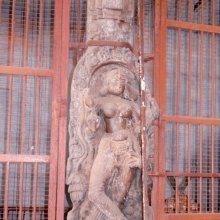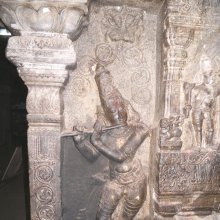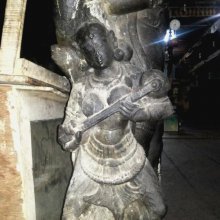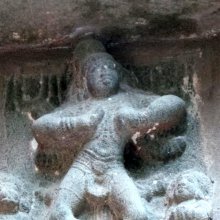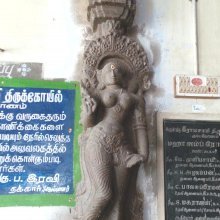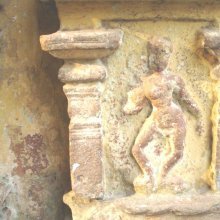Unnata, Uṇṇata, Unnatā: 34 definitions
Introduction:
Unnata means something in Buddhism, Pali, Hinduism, Sanskrit, Jainism, Prakrit, the history of ancient India, Marathi, Hindi. If you want to know the exact meaning, history, etymology or English translation of this term then check out the descriptions on this page. Add your comment or reference to a book if you want to contribute to this summary article.
Images (photo gallery)
(+49 more images available)
In Hinduism
Purana and Itihasa (epic history)
Source: archive.org: Shiva Purana - English TranslationUnnata (उन्नत) refers to “very high”, referring to one of the characteristics of the mountain Kailāsa (the auspicious excellent mountainous abode of Śiva), according to the Śivapurāṇa 2.2.40.—Accordingly, as Brahmā narrated to Nārada:—“[...] accompanied by the gods, sages, Brahmā and others Viṣṇu went to Kailāsa, the auspicious excellent mountainous abode of Śiva. Kailāsa was a favourite abode of the lord where Kinnaras, Apsaras, Siddhas and other divine beings stayed. It was very high [i.e., unnata]. Kailāsa was brilliant with many peaks full of precious gems all round. [...]”.
Source: Cologne Digital Sanskrit Dictionaries: The Purana Index1a) Unnata (उन्नत).—A son of Dyutimat.*
- * Brahmāṇḍa-purāṇa II. 11. 9.
1b) Mountain of Kuśadvīpa.*
- * Matsya-purāṇa 122. 53.
1c) (Mt.) a hill in the Sālmalīdvīpa.*
- * Vāyu-purāṇa 49. 33; Viṣṇu-purāṇa II. 4. 26.

The Purana (पुराण, purāṇas) refers to Sanskrit literature preserving ancient India’s vast cultural history, including historical legends, religious ceremonies, various arts and sciences. The eighteen mahapuranas total over 400,000 shlokas (metrical couplets) and date to at least several centuries BCE.
Natyashastra (theatrics and dramaturgy)
Source: Wisdom Library: Nāṭya-śāstra1) Unnatā (उन्नता, “elevated”) refers to a specific gesture (āṅgika) made with the neck (grīvā), according to the Nāṭyaśāstra chapter 8. These ‘gestures of the neck (grīvā)’ should follow the gestures made with the head (śiras). These gestures form a part of the histrionic representation (abhinaya).
2) Unnata (उन्नत, “raised”) refers to a specific gesture (āṅgika) made with the sides (pārśva), according to the Nāṭyaśāstra chapter 10. The sides are one of the six major limbs (aṅga) used to perform certain gestures (āṅgika). These gestures form a part of the histrionic representation (abhinaya).
Source: archive.org: Natya Shastra1) Unnatā (उन्नता).—A type of gesture (āṅgika) made with the neck (grīvā);—Instructions: neck with the face upturned. Uses: in looking up.
2) Unnata (उन्नत, “raised”).—A type of gesture (āṅgika) made with the sides (pārśva);—(Instructions): The other side [on the assumption of the Nata position] will be Unnata (raised), [because in relation of it] the waist, the side, the arm and the shoulder will be raised. (Uses): In going backwards.

Natyashastra (नाट्यशास्त्र, nāṭyaśāstra) refers to both the ancient Indian tradition (shastra) of performing arts, (natya—theatrics, drama, dance, music), as well as the name of a Sanskrit work dealing with these subjects. It also teaches the rules for composing Dramatic plays (nataka), construction and performance of Theater, and Poetic works (kavya).
Ayurveda (science of life)
Source: gurumukhi.ru: Ayurveda glossary of termsUnnata (उन्नत):—Raised or elevated

Āyurveda (आयुर्वेद, ayurveda) is a branch of Indian science dealing with medicine, herbalism, taxology, anatomy, surgery, alchemy and related topics. Traditional practice of Āyurveda in ancient India dates back to at least the first millenium BC. Literature is commonly written in Sanskrit using various poetic metres.
Shaktism (Shakta philosophy)
Source: Google Books: ManthanabhairavatantramUnnatā (उन्नता) refers to a “raised up (line)”.—The Sanskrit texts have generally paid much more attention to the goddess as Speech in deference to the primacy always attributed to it over the written word. Even so, we do find rare references to the goddess as the Line—Rekhā. The Line in its three forms—straight, slanted (tiryañc-rekhā) and “raised up” (unnatā) that constitute the sides of the Triangle, are the three energies and goddesses in which Kubjikā manifests as the Triangle and in which see rests as the Spiral. These are synthesized as aspects of the goddess manifesting progressively to assume the form of a Triangle set in three dimensions commonly represented by a water chestnut (śṛṅgāta).

Shakta (शाक्त, śākta) or Shaktism (śāktism) represents a tradition of Hinduism where the Goddess (Devi) is revered and worshipped. Shakta literature includes a range of scriptures, including various Agamas and Tantras, although its roots may be traced back to the Vedas.
Jyotisha (astronomy and astrology)
Source: Wisdom Library: Brihat Samhita by VarahamihiraUnnatā (उन्नता) refers to “raised” (e.g., those Ketus having a raised tail), according to the Bṛhatsaṃhitā (chapter 11), an encyclopedic Sanskrit work written by Varāhamihira mainly focusing on the science of ancient Indian astronomy astronomy (Jyotiṣa).— Accordingly, “Jala Ketu is a comet which appears in the west with a raised tail [i.e., unnatā—śikhayāpareṇa connatayā]; it is glossy, when it appears there will be prosperity in the land for 9 months, and the world will be freed from all miseries. Bhava Ketu is a comet visible only for a single night and in the east, possessing a small disc; it is glossy; the tail is bent like that of a lion. There will be unprecedented happiness in the land for as many months as the number of hours for which it continues to be visible; if it should be fearful to look at, fatal diseases will afflict mankind”.

Jyotisha (ज्योतिष, jyotiṣa or jyotish) refers to ‘astronomy’ or “Vedic astrology” and represents the fifth of the six Vedangas (additional sciences to be studied along with the Vedas). Jyotisha concerns itself with the study and prediction of the movements of celestial bodies, in order to calculate the auspicious time for rituals and ceremonies.
Ganitashastra (Mathematics and Algebra)
Source: archive.org: Science And Technology In Medievel India (Math)Unnata (उन्नत) or Unnatavṛtta refers to a “convex surface” representing one of the eight divisions of a circle (vṛtta), as described in the Kṣetragaṇitaśāstra, as mentioned in A. Rahman’s Science and Technology in Medievel India: A bibliography of source materials in Sanskrit, Arabic and Persian.—Ancient and medieval India produced a wide range of scientific manuscripts and major contributions lie in the field of medicine, astronomy and mathematics, besides covering encyclopedic glossaries and technical dictionaries.—The Kṣetragaṇita-śāstra is a Sanskrit mathematical treatise dealing with the art of measuring lands, containing well-defined and established technical terms [e.g., Unnata-vṛtta] wanted for practical use in the Tamil language.

Ganitashastra (शिल्पशास्त्र, gaṇitaśāstra) refers to the ancient Indian science of mathematics, algebra, number theory, arithmetic, etc. Closely allied with astronomy, both were commonly taught and studied in universities, even since the 1st millennium BCE. Ganita-shastra also includes ritualistic math-books such as the Shulba-sutras.
Sports, Arts and Entertainment (wordly enjoyments)
Source: archive.org: Syainika Sastra of Rudradeva with English Translation (art)Unnatā (उन्नता) refers to “long” (i.e., “those birds having a long neck”), according to the Śyainika-śāstra: a Sanskrit treatise dealing with the divisions and benefits of Hunting and Hawking, written by Rājā Rudradeva (or Candradeva) in possibly the 13th century.—Accordingly, [while discussing the yellow-eyed division of hawks]: “Of these birds, if the head is like the hood of a snake, and if the neck is long (unnatā), the wings wide and the chest broad, it is the best of its kind”.

This section covers the skills and profiencies of the Kalas (“performing arts”) and Shastras (“sciences”) involving ancient Indian traditions of sports, games, arts, entertainment, love-making and other means of wordly enjoyments. Traditionally these topics were dealt with in Sanskrit treatises explaing the philosophy and the justification of enjoying the pleasures of the senses.
In Buddhism
Mahayana (major branch of Buddhism)
Source: Wisdom Library: LokottaravādaUnnata (उन्नत) is the name of a Buddha under whom Śākyamuni (or Gautama, ‘the historical Buddha’) acquired merit along the first through nine bhūmis, according to the Mahāvastu. There are in total ten bhūmis representing the ten stages of the Bodhisattva’s path towards enlightenment.
Unnata is but one among the 500 Buddhas enumerated in the Mahāvastu during a conversation between Mahākātyāyana and Mahākāśyapa, both principle disciples of Gautama Buddha. The Mahāvastu is an important text of the Lokottaravāda school of buddhism, dating from the 2nd century BCE.
Source: Wisdom Library: Maha Prajnaparamita SastraUnnata (उन्नत) refers to “(one who is) proud”, according to Mahāprajñāpāramitāśāstra (chapter 41).—Accordingly, “[Digression on a case brought against the Buddha; B. The defense].—[1. Meeting With The Heretics].—Entering into an assembly of heretics, the Buddha knew well that he would not be believed nor accepted in the present lifetime (ihajanman), but he wanted to plant great roots of good (mahānidāna) for future lifetimes (parajanman—parajanmani). Moreover, he wanted to put an end to the slander of the heretics who said: ‘The Buddha is proud (unnata)’. This is the reason why he went personally into their assemblies. [...]”.
Source: academia.edu: A Study and Translation of the Gaganagañjaparipṛcchā1) Unnata (उन्नत) (Cf. Anunnata) refers to the “presence of feeling”, according to the Gaganagañjaparipṛcchā: the eighth chapter of the Mahāsaṃnipāta (a collection of Mahāyāna Buddhist Sūtras).—Accordingly, “Son of good family, the morality of the Boddhisatvas becomes purified by these eight qualities. [...] Further, as for the purity of morality, open space is pure, and pure is also that morality; open space is undefiled, and undefiled is also that morality; open space is calm, and calm is also that morality; open space is without a feeling of superiority, and without a feeling (anunnata-gagana—anunnataṃ gaganam) of superiority is also that morality; [...]”.
2) Unnata (उन्नत) refers to “high” (as opposed to Nata—‘low’), according to the Gaganagañjaparipṛcchā.—Accordingly, “How then, son of good family, the Bodhisattva, having accumulated immeasurable merits, nourishes all living beings? Son of good family, [...] (7) his thoughts are like an earth since there is no high or low (nata-unnata) in his mind; (8) he is free from thoughts by pure morality; (9) his thought is liberated and the gate is free from hindrance by accomplishing all sacrifices; (10) he has perfected memory and eloquence by investigating the dharma; (11) he depends on the knowledge of supernatural powers by going to immeasurable Buddha-fields”.

Mahayana (महायान, mahāyāna) is a major branch of Buddhism focusing on the path of a Bodhisattva (spiritual aspirants/ enlightened beings). Extant literature is vast and primarely composed in the Sanskrit language. There are many sūtras of which some of the earliest are the various Prajñāpāramitā sūtras.
Tibetan Buddhism (Vajrayana or tantric Buddhism)
Source: Wisdom Library: Tibetan BuddhismUnnata (उन्नत) is the name of a Kinnara mentioned as attending the teachings in the 6th century Mañjuśrīmūlakalpa: one of the largest Kriyā Tantras devoted to Mañjuśrī (the Bodhisattva of wisdom) representing an encyclopedia of knowledge primarily concerned with ritualistic elements in Buddhism. The teachings in this text originate from Mañjuśrī and were taught to and by Buddha Śākyamuni in the presence of a large audience (including Unnata).
Source: MDPI Books: The Ocean of HeroesUnnata (उन्नत) refers to “lofty”, according to the 10th-century Ḍākārṇava-tantra: one of the last Tibetan Tantric scriptures belonging to the Buddhist Saṃvara tradition consisting of 51 chapters.—Accordingly: [while explaining the body circle (kāyacakra)]: “[...] The Yoginīs each are lofty (unnata) and fleshy, adorned with a bracelet [on the hands] and have one lock of hair [on the head], replete with every [kind of good] characteristic, and are born of Vārāhī’s lineage. [...]”.

Tibetan Buddhism includes schools such as Nyingma, Kadampa, Kagyu and Gelug. Their primary canon of literature is divided in two broad categories: The Kangyur, which consists of Buddha’s words, and the Tengyur, which includes commentaries from various sources. Esotericism and tantra techniques (vajrayāna) are collected indepently.
General definition (in Buddhism)
Source: Wisdom Library: Dharma-samgrahaUnnata (उन्नत, “bent up”) refers to one of the “twenty form objects” (rūpa) as defined in the Dharma-saṃgraha (section 34). The Dharma-samgraha (Dharmasangraha) is an extensive glossary of Buddhist technical terms in Sanskrit (e.g., unnata). The work is attributed to Nagarjuna who lived around the 2nd century A.D.
In Jainism
General definition (in Jainism)
Source: The University of Sydney: A study of the Twelve ReflectionsUnnata (उन्नत) (or Ūrjita) refers to a “great (burning)”, according to the 11th century Jñānārṇava, a treatise on Jain Yoga in roughly 2200 Sanskrit verses composed by Śubhacandra.—Accordingly, “Those possessions which are pitiless, having imparted a great burning (unnata—dattvā dāham unnatam) in the heart of men, certainly will go away. How could they be for your pleasure?”.

Jainism is an Indian religion of Dharma whose doctrine revolves around harmlessness (ahimsa) towards every living being. The two major branches (Digambara and Svetambara) of Jainism stimulate self-control (or, shramana, ‘self-reliance’) and spiritual development through a path of peace for the soul to progess to the ultimate goal.
India history and geography
Source: Cologne Digital Sanskrit Dictionaries: Indian Epigraphical GlossaryUnnata.—(IE 8-5), high land. Note: unnata is defined in the “Indian epigraphical glossary” as it can be found on ancient inscriptions commonly written in Sanskrit, Prakrit or Dravidian languages.

The history of India traces the identification of countries, villages, towns and other regions of India, as well as mythology, zoology, royal dynasties, rulers, tribes, local festivities and traditions and regional languages. Ancient India enjoyed religious freedom and encourages the path of Dharma, a concept common to Buddhism, Hinduism, and Jainism.
Languages of India and abroad
Pali-English dictionary
Source: BuddhaSasana: Concise Pali-English Dictionaryunnata : (pp. of unnamati) raised; high; lofty.
Source: Sutta: The Pali Text Society's Pali-English DictionaryUṇṇata, (adj.) (pp. of uṇṇamati, Sk. unnata) raised, high, fig. haughty (opp. oṇata) A. II, 86; Sn. 702 (an° care = uddhaccaṃ n’āpajjeyya SnA 492); Pug. 52 (= ucca uggata Pug. A 229). Cp. unnata. (Page 130)
— or —
Unnata, (pp. of unnamati. Besides this form we find uṇṇata in fig. special meaning, q. v. ) raised, high, lofty, in high situation (opp. oṇata) Pv IV. 66 (= sāmin PvA. 262); J. I, 71; II369; VI 487; Miln. 146, 387; DA. I, 45 See also unnaḷa. (Page 138)

Pali is the language of the Tipiṭaka, which is the sacred canon of Theravāda Buddhism and contains much of the Buddha’s speech. Closeley related to Sanskrit, both languages are used interchangeably between religions.
Marathi-English dictionary
Source: DDSA: The Molesworth Marathi and English Dictionaryunnata (उन्नत).—n S unnatāṃśa m S unnati f S Altitude (of a heavenly body): opp. to natāṃśa Declination.
--- OR ---
unnata (उन्नत).—a S High or tall.
Source: DDSA: The Aryabhusan school dictionary, Marathi-Englishunnata (उन्नत).—a High, tall.
Marathi is an Indo-European language having over 70 million native speakers people in (predominantly) Maharashtra India. Marathi, like many other Indo-Aryan languages, evolved from early forms of Prakrit, which itself is a subset of Sanskrit, one of the most ancient languages of the world.
Sanskrit dictionary
Source: DDSA: The practical Sanskrit-English dictionaryUnnata (उन्नत).—p. p.
1) Raised, elevated, uplifted (fig. also); त्रिरुन्नतं स्थाप्य समं शरीरम् (trirunnataṃ sthāpya samaṃ śarīram) Śvet. Up.2.8; उपासितगुरुप्रज्ञा- भिमानोन्नताः (upāsitaguruprajñā- bhimānonnatāḥ) Bhartṛhari 3.24; Śiśupālavadha 9.79; नतोन्नतभूमिभागे (natonnatabhūmibhāge) Ś.4.15.
2) High (fig. also), tall, lofty; great, eminent; स्थितः सर्वोन्नतेनोर्वीं क्रान्त्वा मेरुरिवात्मना (sthitaḥ sarvonnatenorvīṃ krāntvā merurivātmanā) R.1.14; V.5.22; Kirātārjunīya 5. 15,14.23; Pañcatantra (Bombay) 1.29; °इच्छः (icchaḥ) R.6.71; Śiśupālavadha 7.27; °चेतस् (cetas) a. noble-minded; Pañcatantra (Bombay) 1.122.
3) Projecting, plump, full (as breasts); निबिडोन्नतस्तनम् (nibiḍonnatastanam) M.2.3; Ṛtusaṃhāra 1.7.
4) Pleased, in high spirit; समाधाय समृद्धार्थाः कर्मसिद्धिभिरुन्नताः (samādhāya samṛddhārthāḥ karmasiddhibhirunnatāḥ) Rām.5.61.5.
-taḥ A boa (ajagara).
-tam 1 Elevation.
2) Ascension, altitude.
Source: Cologne Digital Sanskrit Dictionaries: Edgerton Buddhist Hybrid Sanskrit DictionaryUnnata (उन्नत).—(1) adj. (ppp.; compare prec. and next; not recorded in this evil sense), arrogant: Mahāvastu i.305.15 uddhatāṃ unna- tāṃ dṛṣṭvā capalāṃ…; Śikṣāsamuccaya 158.5 bodhisattvo 'n-unnata- vīryo bhavati; (2) name of a former Buddha: Lalitavistara 5.8; Mahāvastu i.137.12 (here of course in the good sense recorded in Sanskrit and Pali, lofty).
Source: Cologne Digital Sanskrit Dictionaries: Shabda-Sagara Sanskrit-English DictionaryUnnata (उन्नत).—mfn.
(-taḥ-tā-taṃ) 1. High, tall. 2. Raised, held or lifted up. 3. Plump, full. 4. Great, eminent. E. ut high, nata bent.
Source: Cologne Digital Sanskrit Dictionaries: Cappeller Sanskrit-English DictionaryUnnata (उन्नत).—[adjective] raised, high, eminent; [neuter] = seq.
Source: Cologne Digital Sanskrit Dictionaries: Aufrecht Catalogus CatalogorumUnnata (उन्नत) as mentioned in Aufrecht’s Catalogus Catalogorum:—(?): Nibandhasaṃgraha Suśrutaṭīkā. K. 212.
Source: Cologne Digital Sanskrit Dictionaries: Monier-Williams Sanskrit-English Dictionary1) Unnata (उन्नत):—[=un-nata] [from un-nam] mfn. bent or turned upwards, elevated, lifted up, raised, high, tall, prominent, projecting, lofty, [Mahābhārata; Śakuntalā; Hitopadeśa] etc.
2) [v.s. ...] (figuratively) high, eminent, sublime, great, noble, [Kathāsaritsāgara; Bhartṛhari; Sāhitya-darpaṇa] etc.
3) [v.s. ...] having a large hump, humpbacked (as a bull), [Vājasaneyi-saṃhitā; Taittirīya-saṃhitā; Lāṭyāyana]
4) [v.s. ...] m. a boa (aja-gara), [cf. Lexicographers, esp. such as amarasiṃha, halāyudha, hemacandra, etc.], Name of a Buddha, [Lalita-vistara]
5) [v.s. ...] of one of the seven Ṛṣis under Manu Cākṣuṣa, [Viṣṇu-purāṇa]
6) [v.s. ...] of a mountain, [Viṣṇu-purāṇa]
7) [v.s. ...] n. elevation, ascension
8) [v.s. ...] elevated part, [Taittirīya-saṃhitā]
9) [v.s. ...] means of measuring the day, [Siddhāntaśiromaṇi; Sūryasiddhānta]
Source: Cologne Digital Sanskrit Dictionaries: Yates Sanskrit-English DictionaryUnnata (उन्नत):—[unna+ta] (taḥ-tā-taṃ) a. High.
Source: DDSA: Paia-sadda-mahannavo; a comprehensive Prakrit Hindi dictionary (S)Unnata (उन्नत) in the Sanskrit language is related to the Prakrit words: Uṇṇai, Uṇṇaya.
[Sanskrit to German]
Sanskrit, also spelled संस्कृतम् (saṃskṛtam), is an ancient language of India commonly seen as the grandmother of the Indo-European language family (even English!). Closely allied with Prakrit and Pali, Sanskrit is more exhaustive in both grammar and terms and has the most extensive collection of literature in the world, greatly surpassing its sister-languages Greek and Latin.
Hindi dictionary
Source: DDSA: A practical Hindi-English dictionaryUnnata (उन्नत) [Also spelled unnat]:—(a) elevated; high; developed; lofty; improved.
...
Kannada-English dictionary
Source: Alar: Kannada-English corpusUnnata (ಉನ್ನತ):—
1) [adjective] raised; elevated; uplifted.
2) [adjective] high; tall; lofty; of higher grade, rank, etc.
3) [adjective] great; excellent; eminent.
4) [adjective] ಉನ್ನತೋನ್ನತ [unnatonnata] unnatōnnata higher and higher; 2. highly excellent or eminent; ಉನ್ನತವಾಗು [unnatavagu] unnatavāgu to be raised, elevated or uplifted; 2. to become taller, loftier, etc.; 3. to become excellent, eminent.
--- OR ---
Unnata (ಉನ್ನತ):—[noun] a man of excellence, eminence or noble quality.
Kannada is a Dravidian language (as opposed to the Indo-European language family) mainly spoken in the southwestern region of India.
Nepali dictionary
Source: unoes: Nepali-English DictionaryUnnata (उन्नत):—adj. 1. prosperous; of high quality; risen; 2. high; tall; 3. sublime; 4. improved; developed; advanced;
Nepali is the primary language of the Nepalese people counting almost 20 million native speakers. The country of Nepal is situated in the Himalaya mountain range to the north of India.
See also (Relevant definitions)
Starts with (+12): Unnataadhyayana, Unnatabba, Unnatabhumi, Unnatacarana, Unnatacchaya, Unnatacharana, Unnatadarpana, Unnatadhikara, Unnatagatra, Unnatakala, Unnatakkori, Unnatakokila, Unnatam, Unnatamasura, Unnatamsha, Unnatamsha-kona, Unnatamsha-prabhava, Unnatanabhi, Unnatanata, Unnatapitha.
Ends with (+14): Abbhunnata, Abhyunnata, Akshunnata, Anunnata, Appapunnata, Ardhonnata, Atyunnata, Cunnata, Grivonnata, Karunnata, Katapunnata, Kayapagunnata, Mahonnata, Masapunnata, Natonnata, Nimnonnata, Ninnunnata, Pagunnata, Paripunnata, Pinonnata.
Full-text (+70): Unnatashiras, Unnatanata, Aunnatya, Unnatanabhi, Nimnonnata, Unnatakala, Unnaya, Unnatatva, Unnatakokila, Unnatacarana, Anunnata, Unatakokila, Utkuta, Mahonnata, Abhyunnata, Unateccha, Samabhyunnata, Unnatam, Samuddhatalangula, Anunnatagatra.
Relevant text
Search found 23 books and stories containing Unnata, Uṇṇata, Unnatā, Un-nata; (plurals include: Unnatas, Uṇṇatas, Unnatās, natas). You can also click to the full overview containing English textual excerpts. Below are direct links for the most relevant articles:
Sahitya-kaumudi by Baladeva Vidyabhushana (by Gaurapada Dāsa)
Text 10.71 < [Chapter 10 - Ornaments of Meaning]
Text 10.60 < [Chapter 10 - Ornaments of Meaning]
Text 7.110 < [Chapter 7 - Literary Faults]
The Skanda Purana (by G. V. Tagare)
Chapter 329 - Greatness of Unnata-Vināyaka < [Section 1 - Prabhāsa-kṣetra-māhātmya]
Chapter 321 - Greatness of Brahmā < [Section 1 - Prabhāsa-kṣetra-māhātmya]
Chapter 319 - Greatness of Unnata Sthāna < [Section 1 - Prabhāsa-kṣetra-māhātmya]
Vishnudharmottara Purana (Art and Architecture) (by Bhagyashree Sarma)
1.3. Elements of Drama (c): Bodily Movements < [Chapter 3 - Drama and Dance]
Garga Samhita (English) (by Danavir Goswami)
Verse 3.1.27 < [Chapter 1 - The Worship of Śrī Girirāja]
Verse 5.19.20 < [Chapter 19 - The Festival on Śrī Kṛṣṇa Return]
Verse 2.17.13 < [Chapter 17 - The Meeting of Śrī Rādhā-Kṛṣṇa]
Historical Elements in the Matsya Purana (by Chaitali Kadia)
Saptadvīpa (3): Kuśadvīpa < [Chapter 4 - Geographical history in the Matsya-Purāṇa]
